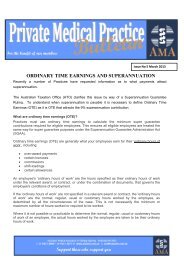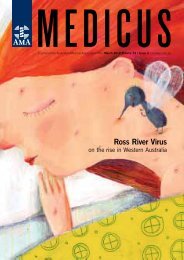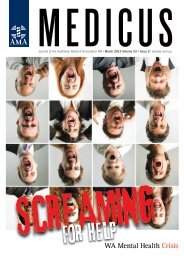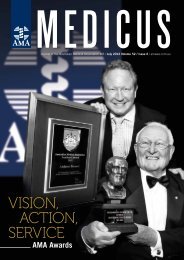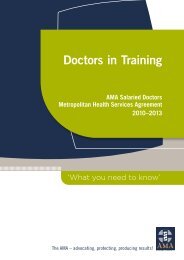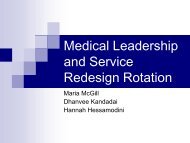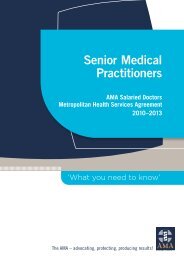twrama 1990_final oc.. - AMA WA
twrama 1990_final oc.. - AMA WA
twrama 1990_final oc.. - AMA WA
You also want an ePaper? Increase the reach of your titles
YUMPU automatically turns print PDFs into web optimized ePapers that Google loves.
TOMORROW’S HEALTH<br />
in screening the at-risk population for neurodegenerative<br />
disease such as Alzheimer’s and Parkinson’s disease and<br />
instituting therapy before the development of symptoms.<br />
Inflammatory diseases of the CNS such as multiple sclerosis<br />
will be more accurately defined and categorised at a much<br />
earlier stage. Cancer patients’ chemotherapy efficacy will<br />
be determined after a single dose of the drug by the ability<br />
to determine with PET/MRI whether the drug attaches to<br />
the tumor receptors and will be effective – personalising the<br />
treatment to the individual patient.<br />
MRI contrast media linked to specific antibodies will<br />
lead to definitive diagnoses without the need for invasive<br />
pr<strong>oc</strong>edure in many organs with clinical and radiological<br />
features of a disease.<br />
High field MRI spectroscopy will supplement the imaging<br />
data and pinpoint metabolic pathways, which are deranged<br />
in various disease pr<strong>oc</strong>esses in all parts of the body to both<br />
confirm the diagnosis and aid therapeutic decisions.<br />
Angiographic assessment of very small vessels including<br />
coronary artery branches, renal artery branches, intracranial<br />
artery branches and digital artery branches will be non<br />
invasive.<br />
Imaging requests and patient appointments will be<br />
electronic and clinical details will be available to the<br />
radiologist via e-health links. This will ensure that an<br />
appropriate imaging study is carried out to answer the<br />
clinical question asked. All imaging will be digital and placed<br />
on a central server in a secure l<strong>oc</strong>ation (e.g. the Health<br />
Department) regardless of where the imaging is carried out.<br />
All imaging providers will be linked to the central server to<br />
download the imaging data and the report, with immediate<br />
access of this data when a patient provides the authority to do<br />
so. The federal e-health program will in due course allow this<br />
to come about.<br />
All metropolitan, remote and rural hospitals will be linked<br />
via PACS and e-health consultation with specific imaging<br />
specialists for an opinion on difficult cases. This opinion may<br />
be sought at a state, national or indeed at an international<br />
level. This will ensure that there is ‘value added’ to the<br />
specialist referrer in the opinion offered.<br />
Interventional radiology: Image-guided<br />
interventional pr<strong>oc</strong>edures and developments in techniques will<br />
further reduce the need for surgical interventions. Ablation<br />
of solid tumors will be more effective than present with lasers<br />
of specific wavelengths for application in the thorax, liver,<br />
kidneys and osseous structures. Image-guided delivery of<br />
chemotherapeutic agents, via direct placement (as in vertebrae,<br />
liver and kidneys and other solid organs) or via micro catheters<br />
as in brain lesions, will increase the efficacy of these agents<br />
minimising systemic side effects.<br />
Stent placement in blood<br />
vessels, ducts and hollow<br />
viscera will be much<br />
more accurate with<br />
‘CT/angiography’ as<br />
currently employed About 15 per cent of the<br />
in intracranial<br />
health care budget is<br />
vascular<br />
interventions.<br />
consumed by imaging, of<br />
Developments<br />
which about 20 per cent is<br />
are underway<br />
to manufacture<br />
inappropriate<br />
biodegradable and<br />
bioactive stents, ass<strong>oc</strong>iated<br />
with fewer long-term<br />
complications.<br />
Stroke management has advanced<br />
significantly in the last decade or so with the use of thrombolytic<br />
agents-administered IV. Dedicated stroke units with 24/7<br />
service and rapid clinical and imaging triage will be the norm.<br />
Patients with large clot burdens will be managed with both<br />
IV thrombolytics and direct clot retrieval by highly-trained<br />
interventional neuroradiologists. This model is in operation at<br />
several l<strong>oc</strong>ations worldwide and has a very significant benefit in<br />
patient outcomes. Developments in equipment and devices for<br />
intracranial aneurysm management, ruptured and unruptured,<br />
is leading to an ever-increasing <strong>oc</strong>clusion of these lesions via<br />
interventional means. Treatment of intracranial vessel stenosis and<br />
acute <strong>oc</strong>clusions is a challenge, but there is progress towards the<br />
design of appropriate stents.<br />
Research and training: About 15 per cent of<br />
the health care budget is consumed by imaging, of which<br />
about 20 per cent is inappropriate. In part, this is related<br />
to poor communication between referring clinicians and<br />
radiologists and in part, lack of understanding on the part<br />
of the requesting clinician as to which imaging modality is<br />
best suited to answer a particular clinical question. Medical<br />
students need to be exposed to imaging paradigms to<br />
ensure appropriate utilisation of imaging. This can be easily<br />
achieved via a Chair in imaging, which sadly is lacking in<br />
Western Australia. However, this position will come about.<br />
An academic position will stimulate research at a multidisciplinary<br />
clinical, medical student and basic science level<br />
with obvious benefit for the patients of this state.<br />
The molecule is in sight, but it is not the end game. ■<br />
An <strong>AMA</strong> (<strong>WA</strong>) Council Member, Professor Mark Khangure<br />
is a respected clinical neuroradiologist working with SKG<br />
Radiology. He was previously head of Imaging Services at<br />
Royal Perth Hospital.<br />
October MEDICUS 39





